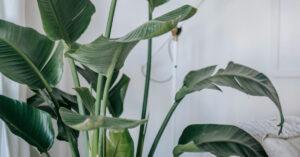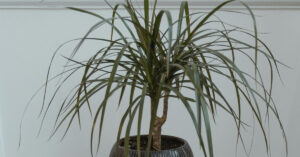Tradescantia zebrina
Few plants can match the stunning visual impact and effortless charm of the Wandering Jew (Tradescantia zebrina). With its vibrant purple undersides, silvery-green striped leaves, and naturally cascading growth habit, this fast-growing trailing plant has become a favorite among both novice and experienced plant enthusiasts. Whether displayed in a hanging basket, perched on a high shelf, or used as ground cover in larger planters, the Wandering Jew creates an instant focal point with its dramatic coloration and flowing form.
Native to Mexico and Central America, this resilient plant has earned its reputation as one of the most forgiving and rewarding houseplants you can grow. The Wandering Jew’s ability to thrive in various conditions, combined with its rapid growth and easy propagation, makes it an ideal choice for anyone looking to add lush, colorful foliage to their indoor garden without the stress of complicated care requirements.
Understanding the Wandering Jew’s Unique Character
The Wandering Jew stands out among houseplants with its distinctive tri-colored foliage that shifts and changes as light hits it from different angles. The top surface of each leaf displays beautiful silver and green stripes, while the underside reveals a rich purple hue that becomes more intense in brighter light conditions. This natural color variation means your plant will look different throughout the day as lighting changes, creating a dynamic display that never becomes boring.
As a trailing plant, the Wandering Jew naturally produces long, cascading stems that can reach several feet in length under good growing conditions. The stems are somewhat succulent-like, storing water and nutrients that help the plant survive periods of neglect. Small nodes along the stems readily produce roots when they come into contact with soil or water, making this plant incredibly easy to propagate and share with friends.
The plant’s common name reflects its vigorous spreading habit and ability to establish quickly in new locations. While this makes it an excellent houseplant, it’s worth noting that in warm climates, the Wandering Jew can become invasive if planted outdoors, so it’s best kept as a container plant in most regions.
Optimizing Light for Vibrant Colors
The key to maintaining the Wandering Jew’s stunning coloration lies in providing the right amount of light. These plants thrive in bright, indirect light that enhances their purple and silver markings without causing leaf burn. A spot near an east or north-facing window, or several feet back from a south-facing window, typically provides ideal lighting conditions.
While the Wandering Jew can tolerate lower light conditions, insufficient light will cause the plant to lose its vibrant colors and become predominantly green. The purple undersides will fade, and the silver striping may become less pronounced. In very low light, the plant also becomes leggy and sparse as it stretches toward available light sources.
Conversely, too much direct sunlight can bleach the leaves and cause them to lose their distinctive markings. If you notice the leaves becoming pale or developing brown, scorched edges, move your plant to a location with gentler light. The ideal balance produces leaves with deep purple undersides and clearly defined silver stripes on the green upper surface.
Mastering the Watering Balance
Wandering Jew plants prefer consistently moist but not waterlogged soil, making them relatively forgiving when it comes to watering schedules. Water when the top inch of soil feels dry to the touch, which typically occurs every 5-7 days during the growing season and less frequently in winter when growth slows.
When watering, apply water evenly across the soil surface until it begins draining from the bottom holes. The plant’s somewhat succulent stems can store water, providing some drought tolerance if you occasionally forget to water. However, consistent moisture will promote the best growth and most vibrant foliage colors.
Overwatering can lead to root rot and mushy stems, while severe underwatering causes the leaves to become crispy and drop off. The Wandering Jew will typically show signs of thirst by slightly wilting or having leaves that feel less plump than usual. During winter months, reduce watering frequency as the plant’s growth naturally slows and it requires less moisture.
Creating the Ideal Growing Medium
The Wandering Jew thrives in well-draining potting soil that retains some moisture while allowing excess water to escape freely. A standard houseplant potting mix works perfectly, though you can improve drainage by adding a small amount of perlite or coarse sand if your soil seems too heavy.
These plants aren’t particularly fussy about soil pH and will grow well in slightly acidic to neutral conditions. The most important factor is ensuring good drainage to prevent root rot while maintaining enough moisture retention to support the plant’s relatively high water needs during active growth periods.
Repotting is rarely necessary with Wandering Jew plants, as they’re often treated as relatively short-term plants due to their tendency to become leggy over time. However, if you choose to repot, do so in spring using a container only slightly larger than the current one, as these plants prefer to be somewhat rootbound.
Temperature and Humidity Requirements
The Wandering Jew adapts well to typical indoor temperatures between 65-75°F (18-24°C), making it suitable for most home environments. These plants can tolerate slightly cooler temperatures but should be protected from cold drafts and sudden temperature changes that can cause leaf drop or stress.
While the Wandering Jew can adapt to average home humidity levels, it appreciates slightly higher humidity when possible. Dry air may cause the leaf tips to brown or the overall growth to slow. If your home is particularly dry, especially during winter heating seasons, consider using a humidifier or grouping plants together to create a more humid microclimate.
The plant’s natural habitat in Central American rainforests means it’s accustomed to warm, humid conditions, but its adaptability makes it suitable for less ideal indoor environments. Just avoid placing it near heating vents, air conditioning units, or frequently opened doors where temperature fluctuations are common.
Fertilizing for Optimal Growth
During the growing season (spring through early fall), feed your Wandering Jew monthly with a balanced, water-soluble fertilizer diluted to half strength. A 10-10-10 or 20-20-20 fertilizer provides the balanced nutrition needed for healthy foliage development and vibrant coloration.
The Wandering Jew’s rapid growth means it can benefit from regular feeding, but over-fertilization can cause excessive, weak growth that’s more susceptible to problems. Signs of over-fertilization include very soft, pale growth and reduced color intensity in the foliage.
During winter months, reduce or eliminate fertilizing as the plant’s growth naturally slows. Resume regular feeding in spring when you notice new growth beginning. Organic fertilizers like compost tea or diluted fish emulsion can also work well and provide gentler, longer-lasting nutrition.
Pruning and Maintenance
Regular pruning is essential for maintaining an attractive Wandering Jew plant. These fast-growing plants naturally become leggy over time, with bare stems at the base and foliage concentrated at the growing tips. Pinch or cut back long stems regularly to encourage bushier growth and prevent the plant from becoming too sparse.
When pruning, cut just above a leaf node to encourage new growth from that point. The removed cuttings can be easily propagated to create new plants or fill in bare spots in the original container. Many growers find it easier to start fresh plants from cuttings rather than trying to rejuvenate old, leggy specimens.
Remove any dead, damaged, or discolored leaves promptly to maintain the plant’s appearance and prevent potential pest or disease issues. The Wandering Jew’s rapid growth means it quickly recovers from pruning and will produce new growth within weeks under good conditions.
Propagation Made Simple
One of the greatest joys of growing Wandering Jew is how incredibly easy it is to propagate. Simply take 4-6 inch cuttings from healthy stems, making sure each cutting includes several nodes (the small bumps where roots will form). These cuttings can be rooted in water or planted directly in moist potting soil.
For water propagation, place cuttings in a glass of water and change the water every few days to prevent bacteria buildup. Roots typically appear within 1-2 weeks, and once they’re about an inch long, the cuttings can be transplanted to soil. This method allows you to watch the root development and ensures successful propagation.
Direct soil propagation works equally well – simply plant the cuttings in moist potting mix and keep the soil consistently moist until new growth appears. This method eliminates the transplant shock that sometimes occurs when moving water-rooted cuttings to soil.
Common Issues and Solutions
Despite its generally trouble-free nature, the Wandering Jew can face several common issues. Spider mites are the most frequent pest problem, especially in dry conditions. These tiny pests cause stippling on leaves and may produce fine webbing. Increase humidity and treat with insecticidal soap or neem oil for effective control.
Leggy growth is perhaps the most common complaint with Wandering Jew plants. This occurs naturally as the plant ages but can be minimized with regular pruning and adequate light. If your plant becomes too leggy, consider starting fresh with new cuttings rather than trying to rejuvenate the old plant.
Loss of coloration usually indicates insufficient light, while pale or bleached leaves suggest too much direct sun. Adjust lighting conditions accordingly, and new growth should show improved coloration within a few weeks.
Decorative Display Ideas
The Wandering Jew’s trailing habit makes it perfect for creative display options. Hanging baskets showcase the cascading stems beautifully, while high shelves allow the foliage to drape gracefully. Consider using multiple plants in a large, shallow planter to create a colorful ground cover effect.
The plant’s rapid growth and easy propagation make it ideal for filling large containers quickly or creating lush displays with multiple plants. Try combining different varieties of Tradescantia for varied textures and colors, or pair with upright plants for contrast in mixed arrangements.
Window boxes, both indoor and outdoor (in appropriate climates), benefit from the Wandering Jew’s trailing habit and colorful foliage. The plant’s ability to root from stem nodes means it can quickly fill spaces and create full, abundant displays.
Embracing the Wandering Jew’s Natural Beauty
Growing Wandering Jew successfully is about working with the plant’s natural tendencies rather than fighting against them. This vigorous grower wants to trail, spread, and multiply – embracing these characteristics rather than constantly trying to control them will lead to the most satisfying experience with this beautiful plant.
The Wandering Jew’s combination of stunning coloration, easy care, and rapid growth makes it an ideal choice for both beginners and experienced plant enthusiasts. Whether you’re looking to add a splash of color to a bright corner or create a dramatic trailing display, this resilient plant delivers beauty and satisfaction with minimal effort, making it a worthy addition to any indoor plant collection.




